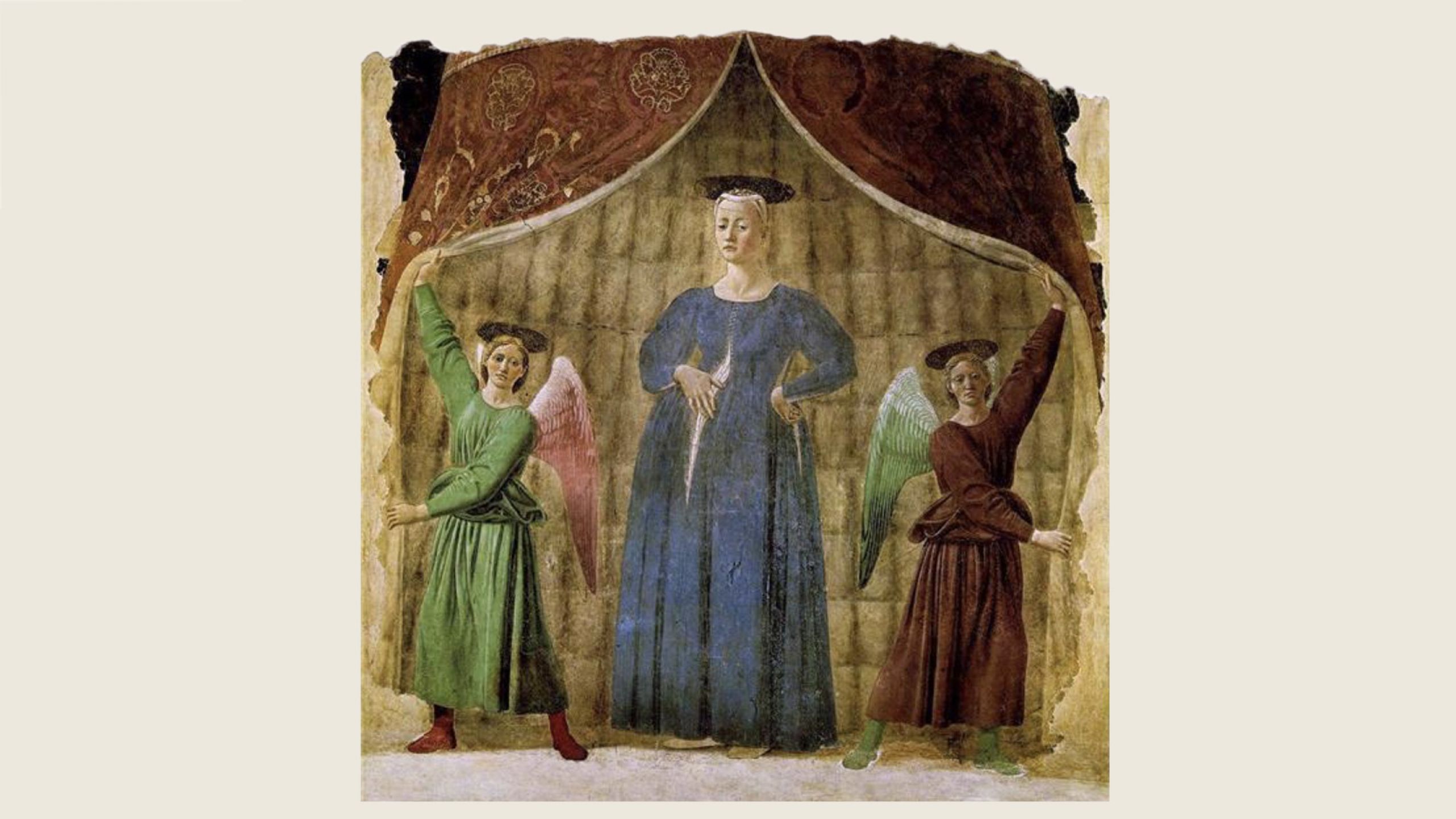The angels look out at us directly as if nothing could ever disturb them. Their faces could never betray any expression other than this, of sheer impassive benevolence. Ataraxia, imperturbability. Yet the bodies, figures, are not light, or slender, they have a credible solidity without weight, standing on feet that are not planted. The angels are a pair, mirrored but not quite: green/pink; purple/green. The same face but not quite. The one in the green dress with pink wings is somehow more beautiful. She is fresh from angel heaven; her twin sister is ruddy. It could be some deterioration in the fresco that makes the face darker and blotched, or it could be that she is just like that. They hold the curtains of the tent open, almost theatrically, for the Madonna to emerge.
She, her left hand in a curious gesture on her hip, the bend at the wrist emphasising the curve of the dress and breadth of her pregnant belly beneath it, stands slightly turned to her right. Her gaze is directed down, she appears unaware of anything or anyone else, neither angels nor viewer, all her attention wrapped around the infant she is carrying. She is entirely self-contained, protected yet also alone. Where is she? No one can say. She is not in our world, yet is the mother of us all. Everything is in the generosity of her being there, about to give birth, but it never happens. It also always happens.
Piero couldn't do hands as well as he could do faces. Her right hand, the one entering the slit, isn't actually right, the wrist isn't feasible, the back of the hand too large and too flat, and the fingers and thumb inarticulate, disjointed. The hand of a poorly conceived mannequin. But of course it doesn't matter. The whole story, the whole power of her is in the gesture and the expression on her face. The stillness and silence are palpable, and speak volumes. What do they say? Something wordless, beyond thought, which we can nevertheless all understand. It's a mysterious communion.
Why do angels have wings? So they can fly? Why would they need to fly? To be not of this world, not quite human, sky dancers, dakinis, those beings between worlds. Piero has painted the feathers with great care; are the large, powerful wings modelled on those of any bird in particular? A swan maybe? These are over half the length of the angel's body, they would weigh heavily, but the angels carry them as if light as a single feather.
In fact nothing in this painting has any weight in any physical sense, the curtains don't seem heavy, lifted effortlessly, though if made of velvet or silk, and lined, as they appear to be, they would be. The angels' dresses, with their strange upwards folds across the midriff, look as though the quantity and weight of the fabric would at least be felt by the one wearing it; the sheer volume of the Madonna's blue dress, with its inner layers, all of it immaterial.
The angels themselves are beyond us, even though they face us directly, displaying the simplicity of their wisdom – they know her secret, what she is pregnant with, what the revelation indicated by her gesture is.
Where did Piero find these women? Were they his mother, sister, wife, daughter, nursemaid, baker's daughter, farmer's wife? Or were they women he met in another world? All refractions of himself; his faces have a similar cast, whether male or female, they are a type. He was not a naturalist; he saw these women, but not in the street, or at his hearth.
It is troubling, somehow, that grey, armoured lining of a tent such as those erected for kings and generals on the battlefield. Cage, or armadillo-like, severe in contrast to the faded crimson velvet or damask exterior with golden embroidered flowers, schematised roses, leaving only their imprint like a watermark on a table or other surface on the left-hand side where the damage may have been.
The grid is repellent, it does not invite us in, perhaps that's why she has come out, the angels have opened the tent, as her dress is open and she is revealing her interior. She doesn't want to be imprisoned anymore; however beautiful and regal its exterior, the inside is oppressive and inhospitable. Against it the elliptical haloes above the angels' and Madonna's heads appear transparent, lending a reddish hue to what lies behind, a golden light refracting the verticals and horizontals.
They are here to show us, once and for all, that we can do perfectly well without the unnecessary complications of existence, such as hopes and fears, unbridled emotion, extremes of any kind; such as finding oneself hovering on the edge of being and not-being, eternity and annihilation, grasping or longing or any type of futility. Even thought is too much, in the face of their utter peace.
